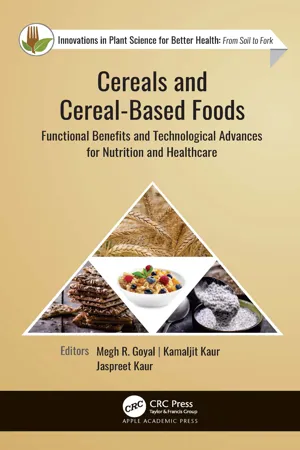
Cereals and Cereal-Based Foods
Functional Benefits and Technological Advances for Nutrition and Healthcare
- 320 pages
- English
- ePUB (mobile friendly)
- Available on iOS & Android
Cereals and Cereal-Based Foods
Functional Benefits and Technological Advances for Nutrition and Healthcare
About this book
This book volume sheds light on the health benefits of selected cereal grains, processing technologies of cereals, specific roles of bioactive compounds of cereals in chronic disease prevention, and traditional and latest technologies to improve the functional benefits of cereal-based products. It presents a thorough review of the functional components of some lesser known or forgotten cereals and their role in maintaining good health.
With advancements in cereal science and technology, new methods of processing have emerged that help to preserve or even enhance the health-benefitting properties of cereal grains. Further, plant breeding and biotechnology have contributed greatly in improving nutritional quality and functionality of these grains. This book provides comprehensive information on the simple as well as advanced methodologies for enhancing the properties of cereals that benefit human health. Some new approaches such as bio-fortification and extraction of bioactives from cereals are also included in the text.
Frequently asked questions
- Essential is ideal for learners and professionals who enjoy exploring a wide range of subjects. Access the Essential Library with 800,000+ trusted titles and best-sellers across business, personal growth, and the humanities. Includes unlimited reading time and Standard Read Aloud voice.
- Complete: Perfect for advanced learners and researchers needing full, unrestricted access. Unlock 1.4M+ books across hundreds of subjects, including academic and specialized titles. The Complete Plan also includes advanced features like Premium Read Aloud and Research Assistant.
Please note we cannot support devices running on iOS 13 and Android 7 or earlier. Learn more about using the app.
Information
PART I
Functional Benefits of Cereal Grains
CHAPTER 1
BARLEY-BASED FUNCTIONAL FOODS
ABSTRACT
1.1 INTRODUCTION
1.2 TYPES OF BARLEY
- Barley with two rows of grains on the head is called two-row barley.
- Barley with four rows is called four-row barley.
- Barley with six rows is called six-row barley.
- (Normal) hooded.
- Awnless or awnletted in central rows and lateral rows.
- Elevated hooded.
- Elevated hoods in central row, and awnless in lateral rows.
- Long awned.
- Long awned in central row, awnletted or awnless in lateral rows.
- Short awned.
- Short awned in central row, awnletted or awnless in lateral rows.
- Subjacent hooded.
1.3 NUTRITIONAL COMPOSITION OF BARLEY
| Component | Unit | Value | Component | Unit | Value |
|---|---|---|---|---|---|
| Moisture | g | 9.77 | Water-soluble vitamins | ||
| Protein | g | 10.94 | Thiamine | mg | 0.36 |
| Ash | g | 1.06 | Riboflavin | mg | 0.18 |
| Total fat | g | 1.30 | Niacin | mg | 2.84 |
| Carbohydrate | g | 61.29 | Pantothenic acid | mg | 0.14 |
| Energy | kJ | 1321 | Biotin | μg | 2.38 |
| Dietary fiber | Total folates | μg | 31.58 | ||
| Total | g | 15.64 | Carotenoids | ||
| Insoluble | g | 9.98 | Lutein | μg | 5.39 |
| Soluble | g | 5.66 | Zeaxanthin | μg | 1.90 |
| Minerals | Total carotenoids | μg | 69.87 | ||
| Magnesium | mg | 48.97 | Minerals | ||
| Manganese | mg | 1.24 | Selenium | μg | 18.61 |
| Phosphorus | mg | 178 | Sodium | mg | 7.56 |
| Potassium | mg | 268 | Zinc | mg | 1.50 |
1.4 BIOACTIVE COMPONENTS OF BARLEY
1.4.1 β-GLUCAN
1.4.2 PHENOLIC ACIDS
Table of contents
- Cover
- Half Title Page
- Title Page
- Copyright Page
- About the Senior Editor-in-Chief
- About Co-Editors
- Table of Contents
- Contributors
- Abbreviations
- Preface
- Part I: Functional Benefits of Cereal Grains
- Part II: Technological Advances in Processing of Cereals for Healthcare
- Part III: Novel Strategies to Enhance Bioactive Compounds in Cereals
- Part IV: Role of Cereals in Disease Management
- Index